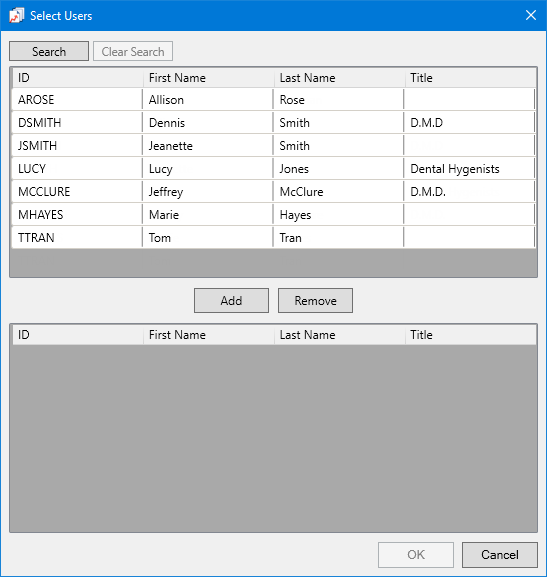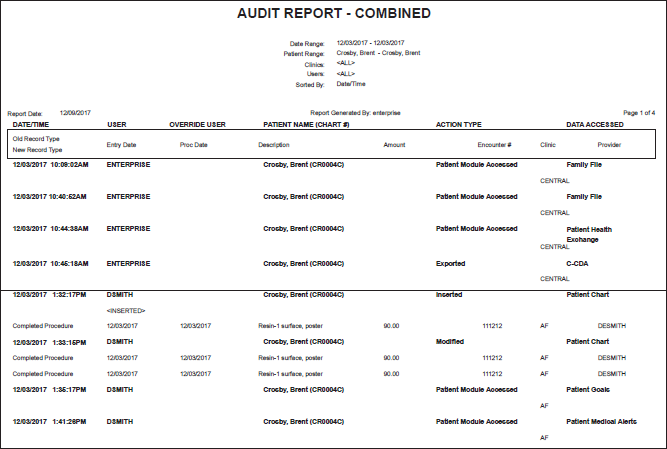The Audit - Combined Report lists patient information that was created, altered, deleted, viewed, printed, and exported during the specified date range. An organization setting controls whether or not these changes or actions are logged in the audit trail.
|
Why: |
To ensure that patient information is being inserted, edited, deleted, accessed, printed, and exported in accordance with the desired security restrictions for each user, and to inform the doctor, office manager, and business owner of any situations so that appropriate action can be taken if necessary |
When: |
Monthly, and as needed |
To generate the report
In DXOne Reporting, select Audit, and then double-click Audit - Combined.
The Audit - Combined dialog box appears.

Set up the following options:
Date Range - To filter the report by date, do one of the following:
To include changes that have dates (based on the Time Zone) within a range that you specify, select the Specific Range option. With this option selected, do one of the following:
Enter a date range (in a m/d/yyyy format) in the From and To boxes.
To select a date, do the following for From and To:
Click the corresponding calendar icon to view a month calendar.

Navigate to the correct month, using the left and right arrows.
Note: To quickly change the year and month, click the month-year at the top of the calendar, navigate to the correct year, using the left and right arrows, and then click the correct month.
Click the correct day.
To include changes that have dates (based on the Time Zone) within a range that is relative to the report date, select the Relative Date Range option. With this option selected, select one of the following relative date ranges from the list:
Current Day Current MTD Current Fiscal YTD Current Calendar YTD |
Previous Day Previous Week Previous Month Previous 3 Months Previous 6 Months Previous Fiscal Year Previous Calendar Year |
Next Day Next Week Next Month Next 3 Months Next 6 Months Next Fiscal Year Next Calendar Year |
Time Zone - Select one of the following options:
Clinic Time - To use the clinic time zone to determine if a change is within the date range for the report.
UTC - To use Coordinated Universal Time to determine if a change is within the date range for the report.
Patient - To filter the report by the patients who are associated with the specified Changes/Actions, do one of the following:
To include all patients in the clinics that you are allowed to generate the report for, select the All checkbox for both From and To.
To include a specific range of patients, select the starting patient (alphabetically by last name) of the range for From and the ending patient of the range for To.
To include a specific patient, select the same patient for both From and To.
To include an open-ended range of patients, select a patient for either From or To, and then select the All checkbox for the other option.
To select a specific patient for From or To, do the following:
Click the corresponding search button
 .
.
The Selection Patients dialog box appears.

Note: Only the patients in the clinics that you are allowed to generate the report for are available.
Do one of the following:
To get a list of all patients, do not enter any search criteria.
To search for patients by last name, birth date, status, chart number, Social Security Number, ID, and/or home phone number, enter the first character or more of a patient's last name, birth date, status, chart number, Social Security Number, ID, and/or home phone number in the Name, Birthday, Status, Chart#, SS#, OtherId, and Home Phone # boxes, respectively.

Note: To clear any text that you have entered, click Clear Search.
Click Show Results to view a list of patients.

Note: To clear the list so you can search again, click Search.
In the list, select a patient.
Click OK.
Clinic - To filter the report by clinics that are associated with the specified Changes/Actions, do one of the following:
To include all clinics that you are allowed to generate the report for, select the All checkbox.
To include specific clinics, do the following:
Click the search button  .
.
The Select Clinics dialog box appears.

Note: Only the clinics that you are allowed to generate the report for are available.
If the list is long, to search for a clinic by ID and/or title, do the following:
Click Search.
The options for searching appear in the upper list.

Enter the first character or more of a clinic's ID and/or title in the ID and Practice Title boxes, respectively.
Click Show Results to view a list of matching clinics.
Note: To return to viewing the list of all the clinics, click Search, click Clear Search to clear the search criteria that you entered, and then click Show Results.
In the upper list, select one or more clinics.
Note: To select multiple clinics, click a clinic, and then, while pressing the Ctrl key, click the other desired clinics. To select a range of adjacent clinics, click the first clinic of the desired range of clinics, and then, while pressing the Shift key, click the last clinic of the desired range of clinics.
Click Add.
Repeat steps b-d as needed to add other clinics.
Note: To not include a clinic that you added, select that clinic in the lower list, and then click Remove.
Click OK.
User Changed - To filter the report by the users who performed the specified Changes/Actions, do one of the following:
To include all users that you are allowed to generate the report for, select the All checkbox.
To include specific users, do the following:
Click the search button  .
.
The Select Users dialog box appears.

Note: Only the users that you are allowed to generate the report for are available.
If the list is long, to search for a user by ID, first name, last name, and/or title, do the following:
Click Search.
The options for searching appear in the upper list.

Enter the first character or more of a user's ID, first name, last name, and/or title in the ID, First Name, Last Name, and Title boxes, respectively.
Click Show Results to view a list of matching users.
Note: To return to viewing the list of all the users, click Search, click Clear Search to clear the search criteria that you entered, and then click Show Results.
In the upper list, select one or more users.
Note: To select multiple users, click a user, and then, while pressing the Ctrl key, click the other desired users. To select a range of adjacent users, click the first user of the desired range of users, and then, while pressing the Shift key, click the last user of the desired range of users.
Click Add.
Repeat steps b-d as needed to add other users.
Note: To not include a user that you added, select that user in the lower list, and then click Remove.
Click OK.
Patient Tag - Do one of the following:
To not filter the report by a patient tag, clear the Run By Patient Tag checkbox.
To filter the report by the tags that are assigned to patients who are associated with the specified Changes/Actions, select the Run By Patient Tag checkbox. With this checkbox selected, the options to filter the report by tag are available. Do one of the following:
To include patients with any patient tag, select the All checkbox.
To include patients with specific tags, do the following:
Click the search button ![]() .
.
The Patient Tag Selection dialog box appears.

If the list is long, to search for a patient tag, do the following:
Click Search.
The options for searching appear in the upper list.

Enter the first character or more of a patient tag name in the Tag Name box.
Click Show Results to view a list of matching patient tags.
Note: To return to viewing the list of all the patient tags, click Search, click Clear Search to clear the search criteria that you entered, and then click Show Results.
In the upper list, select one or more patient tags.
Note: To select multiple patient tags, click a patient tag, and then, while pressing the Ctrl key, click the other desired patient tags. To select a range of adjacent patient tags, click the first patient tag of the desired range of patient tags, and then, while pressing the Shift key, click the last patient tag of the desired range of patient tags.
Click Add.
Repeat steps b-d as needed to add other patient tags.
Note: To not include a patient tag that you added, select that patient tag in the lower list, and then click Remove.
Click OK.
Changes/Actions - Select the check boxes of the types of changes and actions that you want to include on the report. Clear the checkboxes of the types of changes and actions that you do not want to include on the report. To quickly select all check boxes, click Select All. To quickly clear all selected checkboxes, click Clear All. The following checkboxes are available:
Inserted Procedures - The entering of procedures.
Modified Procedures - The editing of procedures.
Deleted Procedures - The deleting of procedures.
Patient Information Accessed - The viewing of patient information.
Printed Patient Reports - The printing of reports with patient information.
Patient Health Exchange Export - The exporting of C-CDA documents.
Emergency Access - The invoking of emergency access to patient information to which you have not been granted security rights.
Note: At lease one checkbox must be selected.
Sort By - Select one of the following options:
Date/Time - To sort the entries on the report by the dates and times of the changes.
User Changed - To sort the entries on the report by the users who made the changes.
Patient Name - To sort the entries on the report by the names of the patients whose information was changed or accessed.
Action Type - To sort the entries on the report by the types of changes.
Data Accessed - To sort the entries on the report by the types of information that were accessed or changed.
Also, from the list, select either Ascending (to put the entries in alphabetical or chronological order) or Descending (to put the entries in reverse alphabetical or chronological order).
Click Save as Default to save the current settings for the next time you run the report.
Click Clear Defaults to revert the dialog box options to the original defaults.
Click Schedule to schedule a report job.
Click OK to preview the report.

Important information this report provides
Date/Time - The date and time of the insertion, alteration, deletion, accessing, printing, or exporting.
User - The user who made the change.
Override User - If another user (user B) entered his or her credentials to allow the user (user A) to make a change because user A didn't have the appropriate rights, user B appears.
Patient Name (Chart #) - The patient whose record was accessed.
Action Type - What action was performed, such as a module was accessed or a C-CDA document was exported.
Data Accessed - The module or area of Dentrix Enterprise that was accessed.
Original Value - Details of the record in its original state.
New Value - Details of the record after the change.